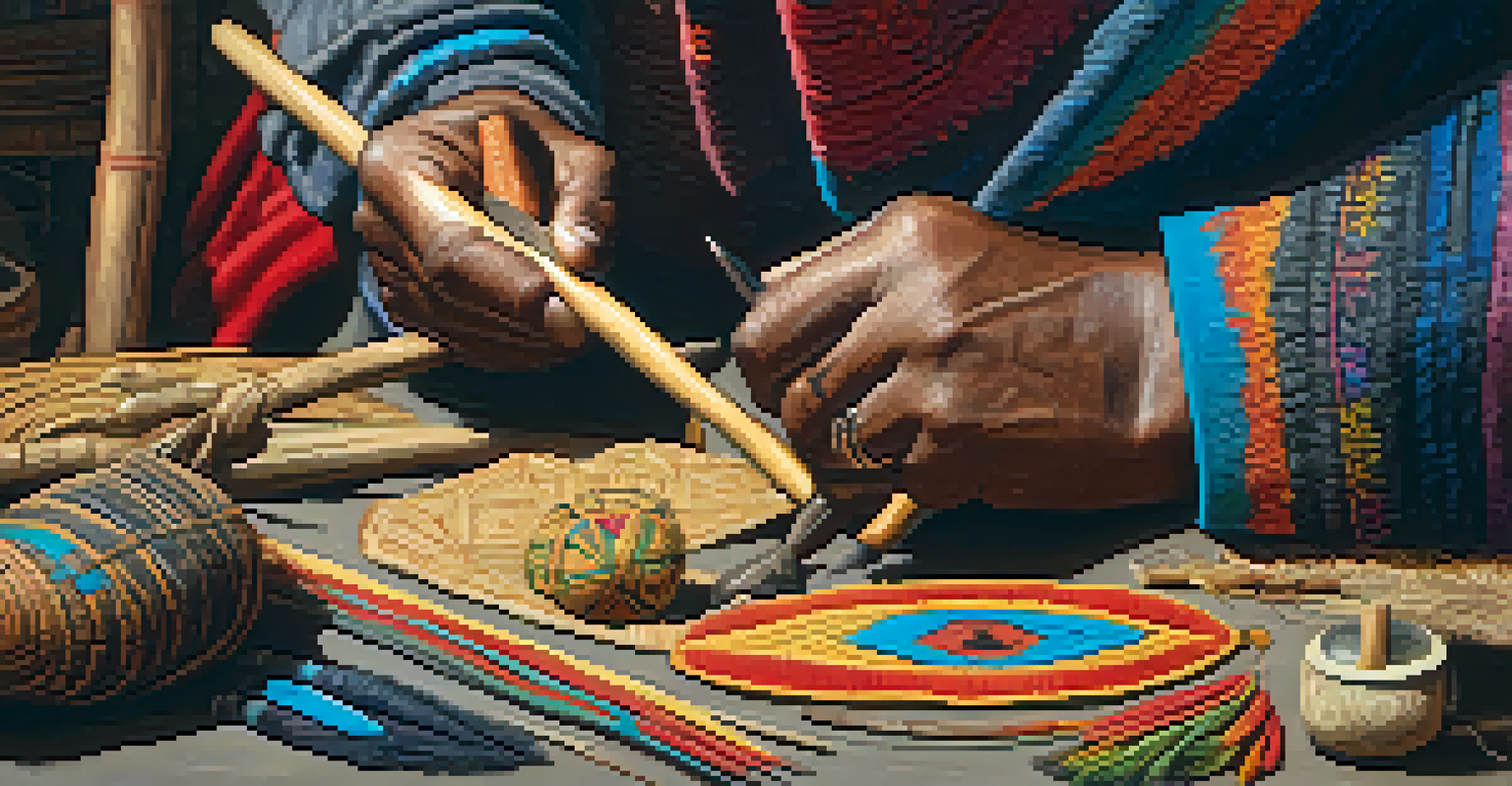Economic Barriers to Indigenous Entheogenic Practices

Understanding Entheogenic Practices in Indigenous Cultures
Entheogenic practices refer to the use of natural substances, such as plants or fungi, to induce altered states of consciousness for spiritual or healing purposes. Many Indigenous cultures have long histories of these practices, often deeply intertwined with their traditions and beliefs. For instance, the use of peyote by Native American tribes demonstrates a rich cultural significance that goes beyond mere recreational use.
The earth does not belong to us; we belong to the earth.
These practices are not just about the substances themselves; they're part of a broader worldview that respects nature and fosters community connections. However, the understanding and appreciation of these practices can be overshadowed by economic challenges. In many cases, Indigenous communities face barriers that make it difficult to continue these time-honored traditions.
As society becomes more interested in entheogenic substances for their therapeutic potential, it's vital to recognize and support the rights of Indigenous peoples to their traditional practices. This not only honors their heritage but also promotes a more inclusive approach to the use of these powerful substances.
Economic Disparities Affecting Indigenous Communities
Economic disparities are a significant barrier for many Indigenous communities, limiting their ability to engage in traditional practices like entheogenic use. Factors such as poverty, lack of access to education, and limited employment opportunities contribute to these challenges. As a result, traditional practices may be sidelined in favor of more immediate economic concerns.

For example, a community struggling with economic hardship might prioritize short-term financial stability over the preservation of cultural rituals. This can lead to a loss of knowledge and practices that have been passed down for generations. Such shifts not only affect the community's cultural identity but also reduce the potential for intergenerational healing and connection.
Indigenous Rights and Practices
Supporting the rights of Indigenous peoples to engage in traditional entheogenic practices is crucial for preserving their cultural heritage.
Understanding these economic disparities is essential for supporting Indigenous rights and practices. By addressing these issues, we can help create an environment where traditional entheogenic practices can thrive alongside modern economic realities.
Legal Restrictions and Economic Barriers
Legal restrictions surrounding the use of entheogenic substances can create significant economic barriers for Indigenous communities. Many countries have stringent drug laws that classify these substances as illegal, limiting access for those who wish to use them for traditional practices. This legal environment can lead to criminalization, further exacerbating economic struggles.
Cultural appropriation is the act of taking or using elements from one culture by members of another culture, especially when the appropriating culture is in a position of power over the appropriated culture.
When Indigenous practices are stigmatized or criminalized, communities may be forced to operate underground, jeopardizing their cultural integrity and safety. Moreover, the lack of legal recognition for these practices often translates into diminished economic opportunities, as communities cannot legally sell or share their traditional knowledge and resources.
Addressing these legal barriers requires a nuanced understanding of Indigenous rights and a commitment to reform policies that respect their cultural heritage. By advocating for legal recognition of entheogenic practices, we can help alleviate economic pressures and support the flourishing of these vital traditions.
Cultural Appropriation and Economic Exploitation
Cultural appropriation occurs when elements of one culture are adopted by another, often without permission or understanding. In the context of entheogenic practices, this can lead to the exploitation of Indigenous knowledge and resources, which can further hinder economic opportunities for these communities. For instance, when outsiders commercialize traditional ceremonies, Indigenous peoples may find themselves sidelined in the very practices that define their identity.
This exploitation not only strips Indigenous communities of potential economic benefits but also dilutes the cultural significance of their practices. It can create a scenario where the true essence of entheogenic experiences is lost to commercialization, reducing them to mere commodities. This can be deeply frustrating for communities that have maintained these practices for centuries.
Economic Barriers Impacting Traditions
Economic disparities and legal restrictions significantly hinder Indigenous communities from practicing and sustaining their traditional entheogenic rituals.
To combat this issue, it's crucial for consumers and businesses to approach Indigenous practices with respect and a commitment to ethical engagement. Supporting Indigenous-led initiatives can help ensure that these practices remain authentic and economically beneficial to the communities that have nurtured them.
Access to Resources: A Key Economic Barrier
Access to resources is a critical factor impacting the ability of Indigenous communities to engage in entheogenic practices. Many communities lack access to the natural environments where these plants grow, whether due to land dispossession or environmental degradation. This not only affects their ability to practice their traditions but also limits their economic opportunities associated with these resources.
For instance, if a community can no longer access sacred plants due to urban development or pollution, they may lose not only a spiritual resource but also potential avenues for economic self-sufficiency. The economic implications extend beyond the immediate loss of resources; they can result in a disconnection from cultural identity and community cohesion.
Addressing these challenges requires concerted efforts to restore land rights and protect natural habitats. By ensuring that Indigenous communities have the support they need to access their traditional resources, we can help preserve their cultural practices and promote economic resilience.
The Role of Education in Overcoming Economic Barriers
Education plays a vital role in helping Indigenous communities navigate the complexities of economic barriers related to entheogenic practices. By fostering greater awareness and understanding of these practices, education can empower communities to reclaim their traditions and advocate for their rights. Programs that focus on traditional knowledge and sustainable practices can enhance both cultural preservation and economic viability.
For example, educational initiatives that teach youth about their cultural heritage can instill a sense of pride and responsibility. This not only helps to keep traditions alive but can also create opportunities for economic development, such as ecotourism or workshops centered around traditional practices. Investing in education can lay the groundwork for a more sustainable future for these communities.
Education's Role in Cultural Preservation
Education empowers Indigenous communities to reclaim their traditions and navigate economic challenges, fostering cultural pride and sustainability.
Moreover, educating the wider public about the significance of Indigenous entheogenic practices can foster respect and support for their rights. As more people understand and appreciate these traditions, there's potential for greater collaboration and economic partnerships that benefit Indigenous communities.
Collaborative Efforts to Support Indigenous Practices
Collaborative efforts between Indigenous communities, policymakers, and support organizations are vital for overcoming economic barriers to entheogenic practices. By working together, these stakeholders can create policies that respect Indigenous rights and promote economic sustainability. Collaboration can take many forms, from legal advocacy to community-led initiatives that reintegrate traditional practices into modern life.
One successful example of collaboration is the establishment of Indigenous-led enterprises that focus on sustainable harvesting and sharing of entheogenic plants. These initiatives not only support economic independence but also reinforce the cultural significance of these practices. They demonstrate how traditional knowledge can coexist with modern business models, creating a win-win situation.

Ultimately, the goal of these collaborative efforts is to empower Indigenous communities to thrive economically while preserving their cultural heritage. By standing in solidarity with Indigenous peoples, we can help ensure that their entheogenic practices continue to be honored and respected in an ever-changing world.